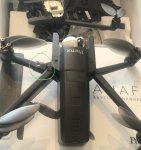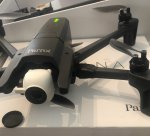- Joined
- Sep 1, 2018
- Messages
- 340
- Reaction score
- 135
Hello Forum, friends,
Recently sat on one of my Anafi while flying with a friend, had placed the Anafi on a lawn chair. Unfortunately, had forgotten it was there and sat on the drone. We heard a crack, no physical damage was noticeable. Everything looked good, so I started to fly it and as it was lifting off the ground the front left leg completely snapped off.
Having a spare crashed Anafi for parts, figured I’d just use a arm from the parts Anafi. Unfortunately, the same parts Anafi arm was broken.
Have repaired other drones before using epoxy and strips of plastic, with the Anafi additional weight can be an issue and needed to keep the repair as light as possible. The three strips of plastic weight was .6 grams, the epoxy was probably around .4 grams. Total additional weight was about .10 grams, that’s 1/10 th of a gram for the repair. It’s auctually stronger now, this is probably the weakest area on the Anafi.
Also used a soldering iron, didn’t have too but wanted to make sure the two broken arm pieces were fastened in proper position before epoxy died. After applying epoxy to the two broken pieces, held both broken arms together and with the soldering iron tack melted all four sides. Just a tack melt to hold the pieces together, then applied additional eqoxy to one side applying a measured strip of plastic, I did this to three sides (both sides/top) each time allowing the epoxy and strip to dry. Takes a few hours to complete, because I’m only epoxying one strip at a time. The soldering iron was only used to melt a small portion of plastic to each side. So everything would dry straight and in original position, you may not need to used a soldering iron but with some repairs it’s critical to be aligned and that’s when I’ll use a soldering iron. The arm will close up against the Gimbal, be careful too long a strip will prevent the arm from fully closing.
Wanted to show it’s possible to repair these broken arms, without adding much weight.
Good luck everyone, have fun and enjoy your outings,
Paul


Recently sat on one of my Anafi while flying with a friend, had placed the Anafi on a lawn chair. Unfortunately, had forgotten it was there and sat on the drone. We heard a crack, no physical damage was noticeable. Everything looked good, so I started to fly it and as it was lifting off the ground the front left leg completely snapped off.
Having a spare crashed Anafi for parts, figured I’d just use a arm from the parts Anafi. Unfortunately, the same parts Anafi arm was broken.
Have repaired other drones before using epoxy and strips of plastic, with the Anafi additional weight can be an issue and needed to keep the repair as light as possible. The three strips of plastic weight was .6 grams, the epoxy was probably around .4 grams. Total additional weight was about .10 grams, that’s 1/10 th of a gram for the repair. It’s auctually stronger now, this is probably the weakest area on the Anafi.
Also used a soldering iron, didn’t have too but wanted to make sure the two broken arm pieces were fastened in proper position before epoxy died. After applying epoxy to the two broken pieces, held both broken arms together and with the soldering iron tack melted all four sides. Just a tack melt to hold the pieces together, then applied additional eqoxy to one side applying a measured strip of plastic, I did this to three sides (both sides/top) each time allowing the epoxy and strip to dry. Takes a few hours to complete, because I’m only epoxying one strip at a time. The soldering iron was only used to melt a small portion of plastic to each side. So everything would dry straight and in original position, you may not need to used a soldering iron but with some repairs it’s critical to be aligned and that’s when I’ll use a soldering iron. The arm will close up against the Gimbal, be careful too long a strip will prevent the arm from fully closing.
Wanted to show it’s possible to repair these broken arms, without adding much weight.
Good luck everyone, have fun and enjoy your outings,
Paul


Last edited:




